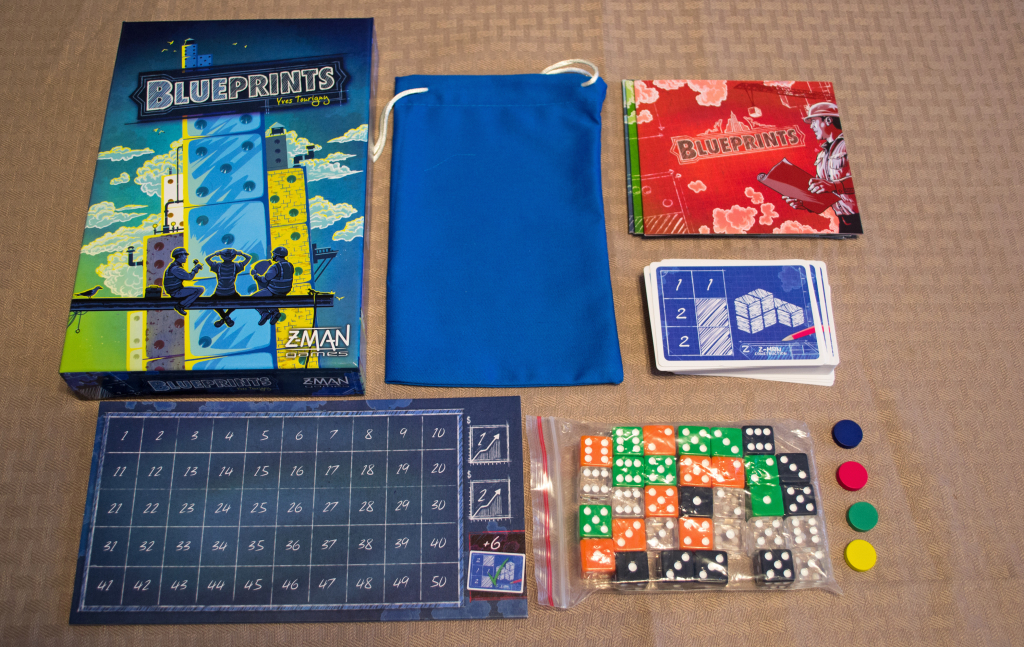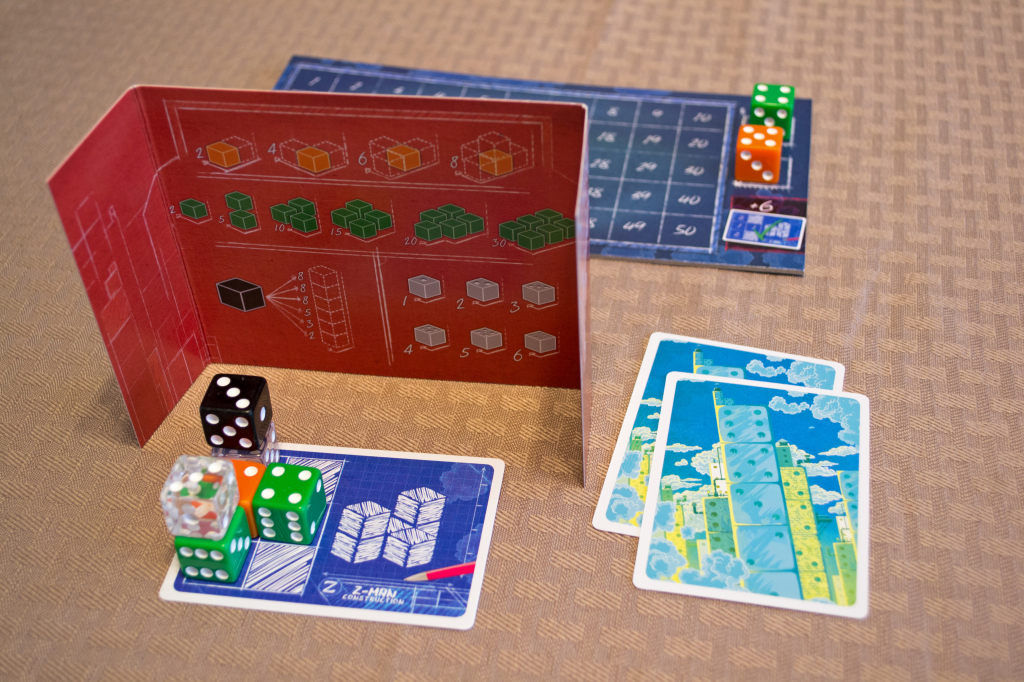Simulators like “Bridge Constructor” are awesome in the sense that they let anyone without an engineering degree flex their creative muscles a bit. There’s also the added benefit of being able to knock it all down (accidentally or intentionally) without actually going to prison for the rest of your life. “Blueprints” is a tabletop abstract building simulator that tasks players with making the best use of the materials available (dice) in order to construct their own towers. How efficient they are with their designs (in accordance with their individual blueprints) will determine how many points they score for any given round. Let’s jump in and get building, shall we?
Components
Dice & Cloth Bag – There are a total of thirty-two dice, made up of four sets of eight dice each. Each set is colored differently and represents a particular material type: clear (glass), orange (wood), green (recycled), and black (steel). There’s also a draw bag for refreshing the available pool of dice every turn.
Blueprint Cards & Screens – There are twenty-four different blueprint cards, each with a unique design. Players will hide their blueprint cards behind individual player screens.
Prize Cards – There are twelve prize cards, made up of four sets of three cards each. Each set lists a different way to score points, mainly by matching a particular pattern. Since the blueprint card lists a particular design already, I like to think of prize cards as optional “side quests” that players can shoot for in order to earn victory points.
Award Cards – There are nine award cards, made up of three sets of three cards each. Sets consist of gold, silver, and bronze cards and are awarded to players appropriately at the end of each round. These cards, along with prize cards, contribute to a player’s victory point total at the end of the game.
Scoreboard & Scoring Markers – Players will track their scores each round with these. These scores will determine who gets what type of award card (victory points) at the round’s end. Scores are reset at the end of each round.
Setup & Gameplay
Each player will choose a matching screen and scoring token. The blueprint cards are shuffled to form a draw deck and all the dice start in the draw bag. The prize & award cards are placed face up in the center of the table into their respective sets (four sets of prize cards & three sets of award cards). Some award card sets may not be used depending on how many people are playing the game.
The game takes place over three rounds. A particular round plays out as follows:
1) Two dice are drawn from the bag and placed on the “in-demand materials” spaces on the scoreboard. The values don’t matter but the two dice must be different colors (the colors help determine who wins tie-breakers).
2) Each player received one blueprint card face-down, who then places it behind their screen face-up.
3) A number of dice are drawn from the bag, are individually rolled, and are placed in the center of the table to serve as a pool for all players. The number of dice drawn is determined by the number of players. There should always be this many available at the start of every player turn.
4) Players determine starting order with play going clockwise from the first player.
5) On a player’s turn, they’ll choose a die from the pool and place it onto their blueprint. A die can be placed on empty spaces (not filled ones) and on top of other dice so as long as its value equals or exceeds the value below it. That player then draws a new die from the bag, rolls it, and places it into the available pool. (The rules for two players are slightly different)
6) After players have drawn and placed six dice, the round ends and blueprint cards are scored/tracked via the scoreboard. Each material or die color is scored in a different way and to top that off, completing the blueprint exactly as shown will score additional points. It’s important to note that these points matter for this round only and are only used to determine who gets award cards (which are scored at the game’s end). If players complete a particular pattern, they’ll earn themselves the matching prize card (again, scored at game’s end). Scores on the scoreboard are reset at the end of each round, though players keep any prize/award cards earned.
Rounds continue in this fashion until three are played. Players count up the points from their accumulated pile of award and prize cards (the scores on the scoreboard don’t count). The player with the most, wins the game!
The above doesn’t cover all of the rules found in the manual, but should give you an idea as to how the game is played. For more information, you can check out the rulebook here:
http://zmangames.com/rulebooks/Blueprints_ENG.pdf
The Review
“Blueprints” isn’t difficult to play, but I’ll admit, it takes some time to get used to how the scoring works. There are two main concepts that will make your life a whole lot easier once you grasp them: 1) award & prize cards are your true victory points and 2) each die color has a different way of scoring. With regard to the former, points you earn on the scoreboard (via the dice & completing your blueprint) only determine who gets an award card. If the pool of dice just aren’t jiving with what you need for your blueprint, you can opt to score some victory points (for endgame scoring) by completing prize cards. As I stated above, I like to call them “side quests” as they are optional, but they can still net you victory points if completing your blueprint and earning enough points on the scoreboard to get an award card just isn’t feasible.
With regards to the latter concept, die color and where you place them is a HUGE part of the determining your round score. Black dice, for example, score more points the higher up they are. Orange dice, on the other hand, score points for every die they touch encouraging a player to place them in a central location on their tower. The scoring of green dice are cumulative in that the more you place in your tower, the more points you get. Finally, clear dice simply earn the value listed on the top face. With these scoring rules in mind, it’s relatively easy to come up with an ideal pattern for maximum points in your head, though the ever-changing pool of dice may not always yield the dice you need to make said plans a reality. Of course, you’ll have to observe the equal/escalating value rule as you add floors as well.
Once I got a handle on both of these concepts, playing the game was both easy and enjoyable. Thankfully, turns are extremely easy to carry out physically…pick a die, place it, and replenish the pool for the next player. This allowed me to focus on the strategic parts of the game and on how the scoring works. Since the only real hurdle is getting over the scoring mechanic, most players should be able to have the basics down after a single game. I recommend reserving an extra ten to twenty minutes your first time out to accommodate for this learning curve.
“Blueprints”, as a whole, is a pretty fun and strategic game. Most (if not all) blueprint cards only task you with going two floors high, so stacking and accidentally knocking dice over wasn’t really a problem. The components themselves were colorful and easy to read. The recommended age is thirteen and up, though I can see gifted kids younger than this playing without any issues. For obvious reasons (dice, etc.), toddlers and younger children should be kept away from it. While the game encourages tactical/strategic dice play, it can be played casually assuming all involved aren’t too worried about who wins or loses. It makes an excellent filler in between longer play sessions or as a way to quickly satisfy your light-strategy game fix for the night.
Final Verdict: 8/10
—


